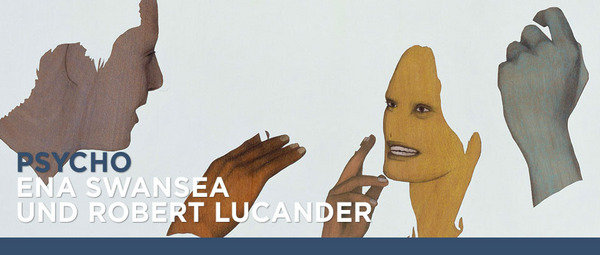Ena Swanser and Robert Lucander
dal 16/12/2011 al 24/3/2012
Segnalato da
Angelika Leu-Barthel - Deichtorhallen
16/12/2011
Ena Swanser and Robert Lucander
Sammlung Falckenberg - Phoenix Kulturstiftung, Hamburg
Psycho. Dreams and emotions form the focus of paintings by Ena Swansea (born in 1965 in North Carolina) - her works bear witness to a fascination with the enigmatic and the power of fantasy. Lucander places special emphasis on the materials and artistic techniques used. Thus the images and montages by the Finnish artist seem to emerge directly from the medium itself, from its grain and the knotholes of the wood.

At the end of this year, the Sammlung Falckenberg will bring together seemingly poetic-surrealist images by US painter Ena Swanser and subversive-enigmatic works by Finnish artist Robert Lucander who now lives in Berlin.
The exhibition’s title of »Psycho« is a reference to the eponymous horror classic by Alfred Hitchcock and calls to mind the disturbed nature of schizophrenics, psychopaths and other psychologically disturbed persons. »Psycho« is Greek for »soul« and the term referring to insanity is derived from the notion that a human’s spirit or soul can become ill; psychoanalysis, for example, is used to treat deep-rooted psychological traumata and behavioral disorders. Bret Easton Ellis’ novel »American Psycho« exposed, for example, the ugly face of unquestioning materialism but left the reader in doubt as to whether the gruesome scenes depicted in the novel emanate from the protagonist’s psychotic fantasies or whether he actually carries out these excessively violent acts. Colloquially, »psycho« is used to describe a mentally disturbed person who displays behavioral problems and a tendency towards aggressive conduct, thus having an unsettling and threatening effect on their environment. The use of this term leads one to expect a confrontation with art that takes non-conformism, insanity and thus the threatening and the sinister as its theme.
Dreams and emotions form the focus of paintings by Ena Swansea (born in 1965 in North Carolina) – her works bear witness to a fascination with the enigmatic and the power of fantasy. They can be interpreted as the expression of subconscious, irrational desires and fears which fester in the depths of one’s memory. Her seemingly transient “dream images” speak to the beholder in a way that only painting can – without the need for words and with a certain sensual immediacy. Those classic genres – the portrait, the group portrait and the landscape – provide Swansea with a medium to express her most intimate feelings. Her painting serves as a form of self-assurance and arises out of a need to confront her own affectivity, her personal fears and traumata, while simultaneously holding a mirror up to the society we all share. The main interest of artist Robert Lucander (born in 1962), now resident in Berlin, likewise lies in portraits and images of our society, albeit in a manner that is far from traditional. In terms of content it is not a matter of capturing the essence of the person depicted, nor is it a classic, creative process of reproducing reality in formal terms. In contrast to the associative illusionism to be discerned in Eva Swansea’s works,
Robert Lucander places special emphasis on the materials and artistic techniques used. Thus the images and montages by the Finnish artist seem to emerge directly from the medium itself, from its grain and the knotholes of the wood. Lucander avails himself of the world of images to be found in magazines and advertising, dissects the colourful media world into fragments and then uses reduction, painting over, montage, mirroring and duplication to create his own visual statements, which only appear superficial and harmless upon first glance. Everyday news stories and newspaper images become the artist’s materials in his subversive and humorous studies of human gestures and facial expressions, whereby he lifts the lid on the social precipices behind the world of beautiful images.
Both the ephemeral-psychological character of Ena Swansea’s paintings and the analytically fragmentary nature and media alienation as manifested in works by Robert Lucander, serve to unsettle the beholder somehow. Both artists upset our viewing patterns, create a subtle feeling of discomfort and expose either one’s own or social reality as »insane«.
opening
Friday, Dezember 16, 2011 at 19 pm. Dirk Luckow (Director of Deichtorhallen), Harald Falckenberg and Miriam Schoofs (Curator) will be speaking at 8.30 pm. The artists will be present.
CATALOGUE
PSYCHO - ENA SWANSEA UND ROBERT LUCANDER. Edited by Dirk Luckow, with essays by Harald Falckenberg, Belinda Grace Gardner and Miriam Schoofs. 56 pages, illustrated. Snoeck Verlag, Cologne. 14,80 Euro.
VISIT
The Falckenberg Collection and the exhibitions can be visited either during the previews or as part of a guided tour. During the exhibitions the latter are held regularly on Wednesdays and Thursdays at 6 pm, Fridays at 5, as well as Saturdays and Sundays at 11 am and 3 pm.
Press Contact: Angelika Leu-Barthel
Deichtorhallen Hamburg
Tel: 040-32103-250 - Fax: 040-32103-230
leu-barthel@deichtorhallen.de
Sammlung Falckenberg
Phoenix Kulturstiftung
Wilstorfer Straße 71, Tor 2 D - 21073 Hamburg - Harburg
Entrance and guided tours: Euro 15 per person Reduced: 12 Euro
Family discounts: Euro 20 (two adults and children)
Combined ticket: 3 Halls for 1 Price: Euro 20 (Hall of Contemporary Art / House of Photography / Falckenberg Collection).
Special guided tours for groups can be arranged for any day.
To register and for further details, please visit www.sammlung-falckenberg.de,
Email: besuch(at)sammlung-falckenberg.de, tel.: +49-40-32506762



